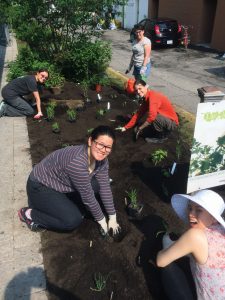Forestry activists call on province for support

PICTURE COURTESY ©ERIN MACDONALD/LEAF: Volunteers tend to LEAF’s Urban Forest Demonstration Garden at the Markham Road entrance of Bathurst subway station.
By Clarrie Feinstein
After paradise was paved over this summer at a North York building site, an organization dedicated to preserving the city’s urban forest hosted a September meeting to discuss how citizens can help enforce Toronto’s tree bylaws. The clearing of 40 trees, including a 150-year-old linden tree, to make way for condominium units was top of mind for many of the approximately 60 people in attendance at the meeting.
“We were very aware of the confusion and frustration that the public felt, which is why we hosted the event,” said Janet McKay, the executive director of Local Enhancement and Appreciation of Forests (LEAF). “We need to reduce the frustrations and clarify what the bylaws can and cannot do.”
Supervisor Mark Ventresca and manager Arthur Beauregard of the City of Toronto’s Urban Forestry division led the discussion on the city’s tree bylaws and explained its tree protection policies.
A city permit is required to remove any tree that is greater than 30 centimetres in diameter. If approval is granted, the removal is monitored, and steps are taken to ensure a new tree is planted in its place. Most tree removals occur in construction zones, and 90 per cent of applications relating to building sites are approved.
If trees are not removed during construction, the builders must install a protective fence around each individual tree. Should a site not comply, a maximum fine per tree of $10,000 would be assessed by the city.
Even unhealthy trees are subject to the approval process.
Beauregard and Ventresca, who said their motto is “all trees are good”, will protect trees until it’s proven that a tree will be a serious safety risk. Even if it is home to an invasive species but still healthy, a tree will not be approved for removal.
The city has made significant progress in regulating tree removals since 2011, stressed Ventresca, who added that there has been a 2.5 per cent increase in tree removal permits over the last eight years.
But Tim Grant, chair of the Harbord Village Residents’ Association (HVRA), said the bylaws still aren’t strong enough.
“We’re losing canopy to pavement,” said Grant. “The violations that occur are routine because there is a lack of enforcement, which then makes people not fear any penalty charges.”
Although most HVRA residents are sensitive to protecting and growing the city’s tree canopy, Grant has witnessed tree bylaw violations in the area. Some years ago, he saw the death of a mature Norway maple in the neighbourhood after homeowners installed flagstones around the tree, strangling its roots in only 12 inches of soil. It’s been four years since the homeowners were told to replace the tree, and still nothing has been done.
“That’s the real trouble,” Grant said, “there is no follow-up. The process is unclear and the policy is not enforced. No one feels the long-term repercussions, but we will soon if we keep treating our trees in this manner.
“By cutting down that maple, there is reduced canopy coverage and privacy. That will have an impact. The lack of species diversity is a huge problem we are currently facing — older trees are nearing the end of their lifetimes.”
Other imminent threats to the tree canopy include invasive forest insects and continuing challenges related to managing invasive plant species, in addition to the uncertain related climate change effects.
The most pressing threat, however, is Toronto’s intensification and rapid development, which is placing increased pressure on the city’s green space and trees.
“Trees should be managed like assets,” said McKay. “If people were to incorporate protecting and maintaining an urban forest like an asset then people are more likely to invest in the maintenance of it.”
According to Every Tree Counts: A Portrait of Toronto’s Urban Forest, trees provide numerous benefits to the city that more than make up for the cost of their upkeep: reduced energy use from heating and cooling of residential buildings, improved air quality, and the absorption of carbon emissions.
All of which makes caring for the urban forest more urgent than ever before.
Yet a report released by the Green Infrastructure Ontario Coalition (GIOC) — an alliance of business, not-for-profit, community groups and local governments working to promote green infrastructure across the province — demands that provincial and federal governments provide meaningful support to help municipalities manage their urban forests as assets.
With 444 municipalities in Ontario, creating a green infrastructure and policy plan from scratch is a task many communities do not have the resources to complete. Even Toronto, which has developed the nation’s leading urban forestry protection plan, only has 40 staff working citywide and very limited resourcing.
“It puts a strain on what we can actually accomplish,” said Ventresca. “We simply do not have enough people and therefore our time is limited.”
He wants to build on Toronto’s first ever Strategic Forest Management Plan, which was approved by Toronto City Council in 2013. It targets increasing the city’s tree canopy cover from 28 to 40 per cent by 2050.
“It’s a lofty goal,” McKay said, “but at least the city has a plan. Now, it’s how can we make this a multilevel government plan.”
READ MORE:
NEWS: Help grow the urban forest (September 2016)
NEWS: Bloor Street goes green (April 2016)
City seeking street greening opportunities: Harbord Village plan targets laneways, parkettes (February 2016)
FOCUS: Urban Elms (September 2015)
